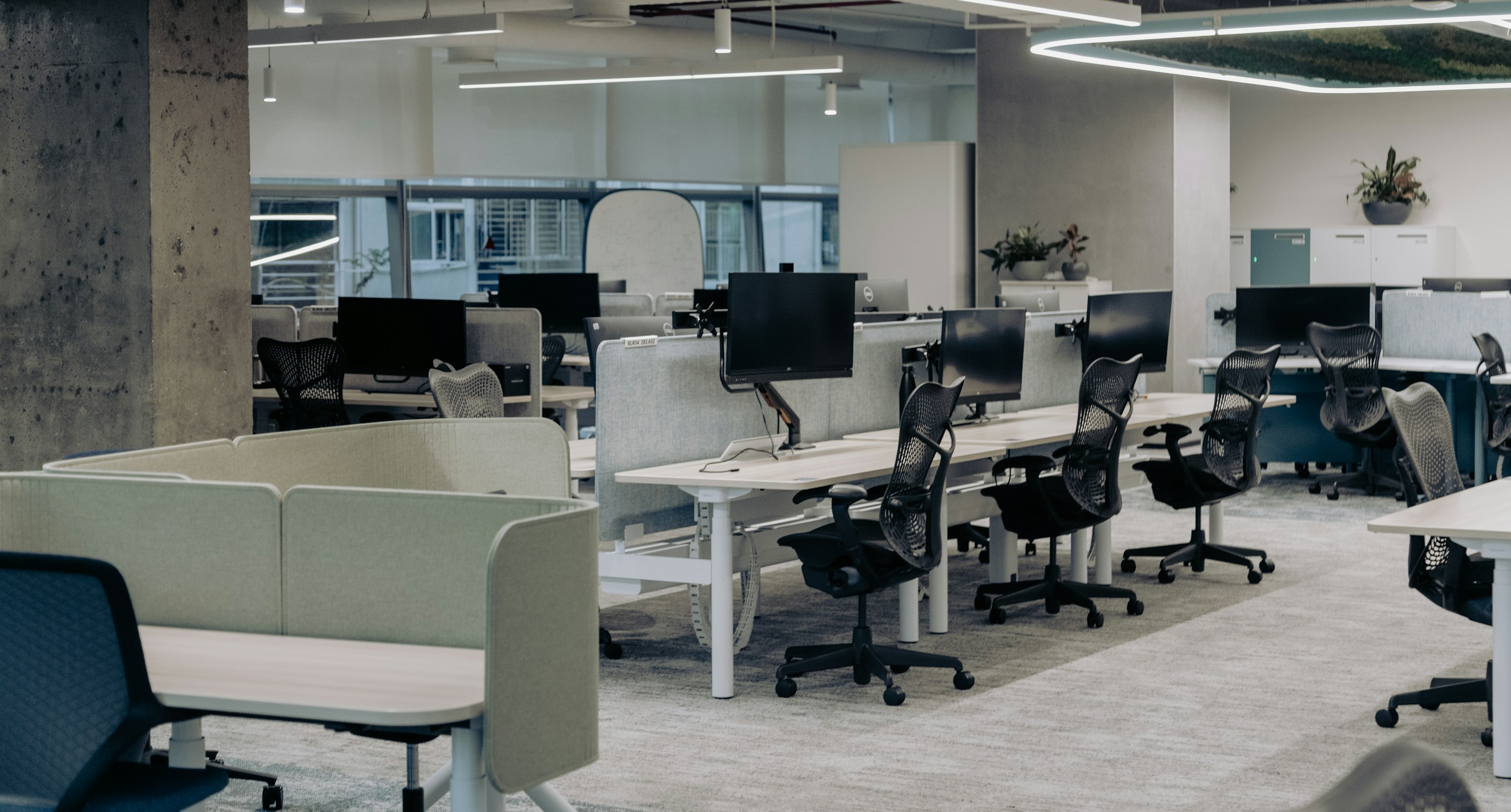The layout and use of physical space within the workplace profoundly impact communication, behaviour, and productivity. One key element in this is proxemics, a concept first introduced by anthropologist Edward T. Hall in 1966. Proxemics refers to the study of how humans use space in interactions and how physical distance can affect communication, relationships, and perceptions of comfort or dominance. When applied to the office environment, proxemics becomes a crucial part of office psychology—the understanding of human behaviour in work settings.
In today’s open-plan offices, the impact of proxemics is increasingly relevant, influencing everything from team collaboration to individual performance.
Understanding Proxemics
The Four Zones of Proxemics
Hall’s theory of proxemics identifies four distinct zones that define personal space:
- Intimate Distance (0–18 inches): This zone is reserved for close personal relationships, such as family members and romantic partners. In an office setting, it is rarely appropriate unless under specific circumstances, such as one-on-one confidential discussions or sensitive negotiations.
- Personal Distance (1.5–4 feet): This zone is typical for conversations between close colleagues or small group discussions. At this distance, people can still engage in direct communication without feeling encroached upon.
- Social Distance (4–12 feet): The most common distance used in workplace settings. This range is typically employed in team meetings, formal discussions, or interactions with unfamiliar colleagues.
- Public Distance (12 feet and beyond): This zone is generally reserved for public speaking, presentations, or addressing larger groups in the office environment.
Understanding these zones helps managers and employees structure their workspace to maximise both comfort and productivity. The way proxemics is managed in the office can create different psychological effects, influencing how people perceive their work environment and interact with colleagues.
Cultural Differences in Proxemics
Proxemic boundaries are culturally dependent. For instance, people from Mediterranean, Middle Eastern, or Latin American cultures often prefer closer proximity when interacting, while Northern Europeans and North Americans may require greater personal space. In a globalised office environment, being aware of these cultural variations can prevent misunderstandings and promote smoother communication.
Example: Misinterpretation of Space in International Offices
Consider a multinational company where employees from different cultural backgrounds share an open office. An employee from Brazil might stand closer to a colleague from the UK during a conversation, leading the British colleague to feel uncomfortable or perceive the Brazilian colleague as overly familiar or even intrusive. This subtle difference in proxemics can lead to misunderstandings, impacting team dynamics if not addressed or understood.
Proxemics in the Workplace: The Open-Plan Office Dilemma
Benefits of Open-Plan Offices
Over the last few decades, open-plan offices have become the dominant style in corporate environments, aiming to reduce barriers between employees and encourage collaboration. The idea behind this design is that fewer physical walls lead to fewer psychological barriers, enhancing communication and transparency within the workforce. Open-plan spaces can:
- Facilitate spontaneous conversations and quick problem-solving
- Encourage teamwork by making it easier to approach colleagues
- Create an egalitarian environment, reducing hierarchy by placing everyone in the same space
Drawbacks of Open-Plan Offices
Despite these benefits, open-plan offices also present significant challenges in terms of proxemics and office psychology:
- Invasion of personal space: Without dedicated offices or cubicles, employees often feel that their personal space is constantly encroached upon. This can lead to feelings of discomfort and stress, reducing overall job satisfaction.
- Increased distractions: A lack of privacy and the proximity of co-workers often lead to distractions, making it harder to concentrate on individual tasks.
- Reduced job satisfaction and autonomy: Some employees may feel that they have lost control over their environment, leading to dissatisfaction and even burnout over time.
Example: Reduced Productivity in Open-Plan Layouts
A study by researchers at Harvard found that rather than fostering more face-to-face interactions, open-plan offices actually led to a 70% drop in these types of exchanges, as employees chose to communicate via email or messaging apps to avoid the distractions of a busy office. Workers were more likely to use headphones and physically distance themselves from colleagues, reducing collaboration—ironically, the exact opposite of the intended goal.
Proxemics and Office Psychology: Creating an Optimal Environment
The Role of Office Design in Employee Well-Being
Good office design can significantly enhance well-being by respecting the proxemic needs of employees. Balancing collaboration with privacy, proximity with distance, can foster a healthier, more productive work environment.
- Dedicated Quiet Zones: Creating areas where employees can focus without interruption is essential. These spaces should respect social distance but allow for moments of ‘personal distance’ when needed for deep work.
- Flexible Seating Arrangements: A flexible office layout that allows workers to choose where they sit depending on the task can improve both comfort and productivity. For example, employees might prefer to work at a communal table when brainstorming but use a quiet booth when they need privacy.
- Incorporating Private Meeting Spaces: Including small meeting rooms or ‘phone booths’ in the office gives employees the option to hold private conversations without disturbing others. These spaces allow for intimate and personal distance, fostering better communication in sensitive discussions.
Example: Google’s Approach to Office Design
Google is well-known for its progressive office designs, which blend open spaces with smaller, more private work areas. Employees are encouraged to use different zones depending on their needs, with proximity to others becoming a matter of personal choice rather than a mandate of the office layout. This flexible approach allows employees to feel empowered, reducing stress and improving both satisfaction and performance.
Leadership and Proxemics
Managers and team leaders can use an understanding of proxemics to improve team dynamics. For instance, when addressing a team, standing too close to employees might feel intimidating, whereas maintaining an appropriate social distance encourages open communication. Similarly, regular one-on-one meetings in private spaces can help build trust and rapport.
Managing Proxemics in Remote and Hybrid Work Environments
Virtual Proxemics
In the era of remote and hybrid work, the concept of proxemics takes on a new dimension. Although employees are no longer sharing physical space, the idea of virtual proxemics—how much ‘digital space’ people feel they need—remains important.
- Camera Placement: In video meetings, participants may feel uncomfortable if a camera is too close to someone’s face or if the framing is too tight. Ensuring an appropriate ‘virtual distance’ can mimic the feeling of personal or social distance found in face-to-face meetings.
- Breakout Rooms for Intimate Discussions: Virtual breakout rooms in platforms like Zoom or Microsoft Teams offer a way to simulate intimate or personal space, providing a place for smaller, focused discussions away from the larger group.
Example: Managing Virtual Meetings
In a company where employees are now mostly remote, managers noticed that some team members rarely contributed during virtual meetings. After experimenting with smaller breakout sessions, they found that many employees were more comfortable speaking in a smaller group, as the ‘social distance’ in the virtual space felt more manageable.
Office Psychology and How Close We Are
Understanding proxemics in the office environment is crucial for creating a workplace that supports both individual productivity and team collaboration. From open-plan designs to hybrid workspaces, the way we use space plays a critical role in office psychology, influencing behaviour, communication, and well-being.
By respecting personal and social distance, designing flexible spaces, and adapting to virtual environments, organisations can foster a work culture that feels both collaborative and considerate, helping employees thrive both individually and collectively.
In the end, proxemics is not just about physical distance; it’s about understanding the psychological space that supports human interaction and workplace harmony.

How do you take a Human-Centric Approach to Proxemics?
A human-centric approach to proxemics involves designing and managing spaces with a deep understanding of people’s emotional, psychological, and social needs. It prioritises comfort, well-being, and the natural ways individuals interact with each other. Here’s how to take a human-centric approach to proxemics in the workplace:
1. Prioritise Personal Comfort
- Respect Personal Space: Ensure the office layout respects the varying comfort levels of employees regarding proximity to others. Some individuals prefer close collaboration, while others may need more personal space to feel at ease. Providing a range of workspaces (communal, semi-private, and private) gives employees the freedom to choose.
- Cultural Sensitivity: Consider cultural differences in personal space preferences. In multinational offices, designing flexible spaces that accommodate different comfort zones can help avoid discomfort or misunderstandings.
2. Promote Autonomy and Flexibility
- Customisable Workspaces: Allow employees to personalise their immediate work area, whether by adjusting seating arrangements or choosing quieter or more open areas. This autonomy enables people to feel more in control of their environment, boosting satisfaction.
- Flexible Seating Options: Providing different zones for different types of work—such as collaborative zones, quiet zones, and break areas—empowers employees to select the proximity and environment they need based on the task at hand.
3. Foster Meaningful Interactions
- Encourage Natural Collaboration: Design spaces that promote organic interactions without forcing proximity. Lounge areas, informal meeting spaces, and well-placed communal areas (e.g., coffee stations) allow employees to interact comfortably without feeling pressured into constant collaboration.
- Balance Open and Private Spaces: Open-plan offices can be productive, but people also need private spaces for focused work or sensitive discussions. Incorporating soundproof booths, private meeting rooms, or dedicated quiet areas helps balance collaboration with privacy.
4. Focus on Well-Being and Mental Health
- Minimise Overcrowding: Crowded or cramped workspaces can increase stress and anxiety. When space planning, ensure that the layout prevents overcrowding, particularly in high-traffic areas like entrances or break rooms, and provides sufficient personal space for each employee.
- Create Restorative Spaces: Include spaces for relaxation and mental breaks, like quiet zones or outdoor areas, to allow employees to retreat when they need distance from others.
5. Leverage Technology Thoughtfully
- Virtual Proxemics: In remote or hybrid work environments, be mindful of virtual proximity. For instance, respect personal boundaries in video calls by ensuring proper camera positioning and using breakout rooms for smaller discussions.
6. Gather Feedback Regularly
- Employee-Centred Design Adjustments: Regularly ask employees for feedback on how the space affects their comfort and productivity. A human-centric approach requires ongoing adjustments based on how people experience and use the space.
By considering individual needs and fostering a comfortable balance between proximity and privacy, a human-centric approach to proxemics enhances the overall work experience, promoting both productivity and employee well-being.


